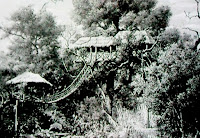 In the 1940s, magician Duke Duquesne has a successful act with his lovely wife Melinda, but when he introduces a new trick guillotine, it malfunctions during a test run and cuts off the head of a doll, which understandably upsets his wife. The next day, she has run off, never to be seen again, and Duke sends their daughter Cassie to live with relatives so he can remain on the road. Twenty years later, Duke dies, never having contacted Cassie, now a grown woman, and his death makes headlines because he has vowed to return from the dead. He has also left his mansion to Cassie with the stipulation that she must spend seven consecutive nights there before she comes into her inheritance. Handsome reporter Val Henderson befriends Cassie at the funeral and poses as a real estate agent in order to gain her trust and get the inside story on the house, and ideally, Duke's return. Stand-offish at first, once they're at the house, Cassis is happy to have Val around as they find the house booby-trapped with spooky tricks, like a skeleton sliding through a room (on a wire) and moaning cries in the night (on tape). Also hanging around are Duke's assistant Dolly—who stands to gain if Cassie doesn't stay the seven nights—and Duke's agent Buzzy. Val doesn’t really think Cassie has anything to worry about—until Dolly reports seeing Duke's ghost. And what about that mysterious locked room? And that cute little bunny that shows up out of the blue? And, BTW, whatever happened to Melinda?
In the 1940s, magician Duke Duquesne has a successful act with his lovely wife Melinda, but when he introduces a new trick guillotine, it malfunctions during a test run and cuts off the head of a doll, which understandably upsets his wife. The next day, she has run off, never to be seen again, and Duke sends their daughter Cassie to live with relatives so he can remain on the road. Twenty years later, Duke dies, never having contacted Cassie, now a grown woman, and his death makes headlines because he has vowed to return from the dead. He has also left his mansion to Cassie with the stipulation that she must spend seven consecutive nights there before she comes into her inheritance. Handsome reporter Val Henderson befriends Cassie at the funeral and poses as a real estate agent in order to gain her trust and get the inside story on the house, and ideally, Duke's return. Stand-offish at first, once they're at the house, Cassis is happy to have Val around as they find the house booby-trapped with spooky tricks, like a skeleton sliding through a room (on a wire) and moaning cries in the night (on tape). Also hanging around are Duke's assistant Dolly—who stands to gain if Cassie doesn't stay the seven nights—and Duke's agent Buzzy. Val doesn’t really think Cassie has anything to worry about—until Dolly reports seeing Duke's ghost. And what about that mysterious locked room? And that cute little bunny that shows up out of the blue? And, BTW, whatever happened to Melinda?This is a run-of-the-mill haunted house flick crossed with a budding romance story between Cassie and Val. Despite the title and the ever-present threat/promise of someone getting beheaded, there is no gore and the tension goes rather slack at times. The pluses: the movie, in rich black & white, looks good and the mansion sets are quite atmospheric; Cesar Romero as Duke is very good, though he doesn't get much screen time; there's a quick, fun turn from Connie Gilchrist as a woman Cassie hires to be her cook. The minuses: Connie Stevens as Cassie (and as Melinda) can never find the right register—she tends to be either over-the-top or bland; the plot is quite predictable and the film dawdles a bit getting to the climax. The middle ground: Dean Jones is interesting as Val—on the surface, he's the clean-cut boy next door, but occasionally he gets an unsettling look of intensity in his eyes that reminded me of Anthony Perkins. Unfortunately, nothing ever comes of that. In general, a middle-ground movie, the kind they don’t make anymore. Made today, this would be either a big-budget action film, an indie gorefest, or a Lifetime TV movie. [DVD]



















